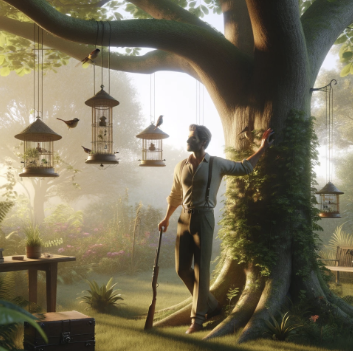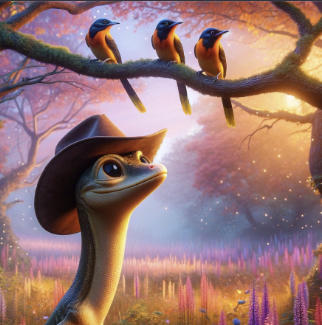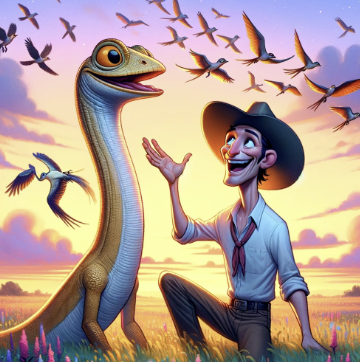One sunny morning, James decided to explore beyond his usual lizard territory and make a visit to a nearby bird sanctuary. He had always been curious about the fascinating creatures that soared through the sky with such grace. As he wandered through the sanctuary, he soon came across a knowledgeable-looking man with a feathered hat and a pair of binoculars hanging around his neck. It was Doug Feathers, the avian expert.

Approaching Doug with excitement, James introduced himself, “Hello, I’m James, the long-necked lizard. I’ve come to learn about birds and their amazing world.”
Doug Feathers smiled warmly and said, “Well, James, you’ve come to the right place! I’m Doug Feathers, and I know a lot about birds. Let me tell you about their world.”
Doug began to explain the intricate mechanics of how birds fly to James. “You see, James, birds have several adaptations that allow them to fly gracefully through the skies. Their most important tools are their wings and feathers. The shape and structure of their wings are designed for efficient lift and thrust. When a bird flaps its wings, it creates lift, which keeps it in the air. The feathers on a bird’s wings and tail help control their direction and speed. Birds also have hollow bones, which make them lightweight and aid in flying.”
James listened intently, trying to imagine what it would be like to have wings and soar through the air like a bird.
After explaining flight, Doug continued, “As for building nests, birds are master builders. They use various materials like twigs, leaves, feathers, and even mud to create cozy homes for themselves and their offspring. Nests are not only for protection but also serve as a place to lay eggs and raise their young. Different bird species have unique nest-building techniques, and it’s truly remarkable to observe their craftsmanship.”

James couldn’t help but admire the dedication and creativity of birds in constructing their nests. He felt like he was learning so much about the avian world, thanks to Doug’s expertise.
“Now, let’s talk about what birds eat, Doug said. “Birds have diverse diets depending on their species. Some are carnivorous and eat insects, small mammals, or fish, while others are herbivores and primarily consume seeds, fruits, and plants. There are even birds that are omnivores and eat a mix of different foods. It’s incredible how they’ve adapted to their environments.”
James was fascinated by the variety of diets among birds and asked, “Do these birds ever eat lizards like me?”
Doug chuckled kindly, “Oh, James, don’t worry. Birds here in the sanctuary don’t eat lizards. They have plenty of other food sources like insects, seeds, and fish. You’re safe here.”
Relieved, James asked, “Doug, you’ve told me so much about birds, but I’m really curious about this thing called ‘migration.’ Can you tell me more about it?”
Doug Feathers smiled, “Of course, James! Bird migration is a fascinating phenomenon. It’s when some bird species travel long distances from one place to another at specific times of the year. They do this for various reasons, such as finding better food sources, escaping harsh weather, or even to breed.”
James listens intently, eager to learn more. “How do they know where to go?” he asks.

Doug explains, “Birds have incredible navigational abilities. Many use the sun, stars, and Earth’s magnetic field to find their way. Some birds have an innate sense of direction, while others learn their migration routes from their parents or flock members.”
James is amazed by the birds’ navigation skills and asks, “Do all birds migrate?”
Doug shakes his head, “No, not all birds migrate. Some stay in one place throughout the year, while others may travel shorter distances. It really depends on the species and their specific needs.”
James is grateful for the explanation, feeling like he’s uncovering a whole new world of knowledge about birds. “Thank you, Doug! Learning about migration is so interesting. Birds are truly remarkable.”
With newfound inspiration, James knew that his migration for knowledge had only just begun. As he bid farewell to Doug Feathers and the bird sanctuary, he carried with him the wisdom of birds and the thrill of learning. He couldn’t wait to continue his adventure, exploring new horizons and uncovering the mysteries of the natural world, one question at a time. And so, with each step he took, James the long-necked lizard embarked on a journey that would lead him to endless discoveries, much like the birds in their timeless migrations across the skies.

